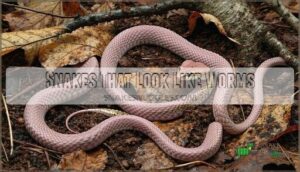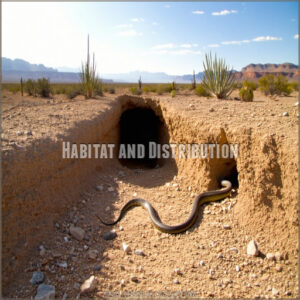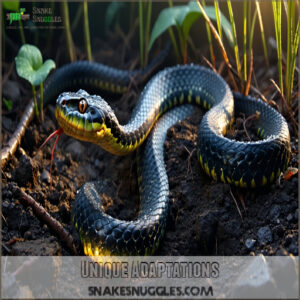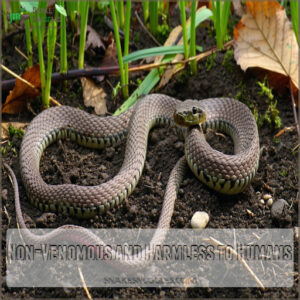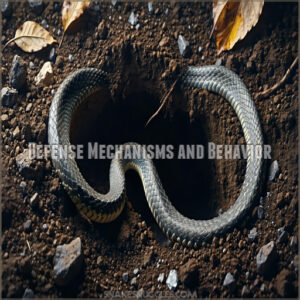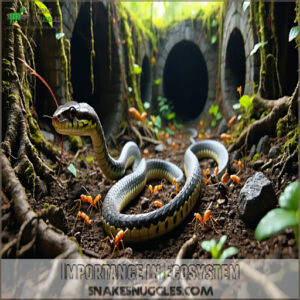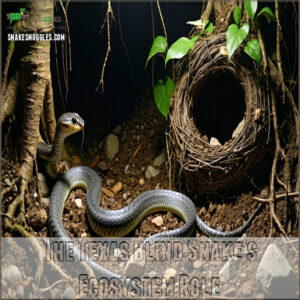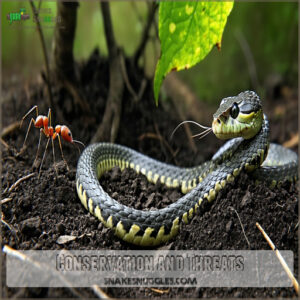This site is supported by our readers. We may earn a commission, at no cost to you, if you purchase through links.
 If you’ve ever mistaken a snake for a worm, you’re not alone.
If you’ve ever mistaken a snake for a worm, you’re not alone.
Snakes like the Texas Blind Snake or Brahminy Blind Snake look strikingly worm-like, they’re tiny—often just a few inches long—with smooth, shiny scales and a pinkish-brown color that resembles earthworms.
Look closely, though, and you’ll notice they lack the segmented rings that worms have.
These fascinating snakes live underground, thriving in loose soil, and feed on ants and termites.
Despite their resemblance to worms, they’re actual snakes with eyes (super tiny ones!) and a knack for pest control.
Curious about their role in ecosystems? It gets even cooler.
Table Of Contents
- Key Takeaways
- Snakes That Look Like Worms
- Is The Texas Blind Snake Harmful?
- The Texas Blind Snake’s Ecosystem Role
- Conservation and Threats
- Debunking Misconceptions
- Frequently Asked Questions (FAQs)
- Do Worm snakes look like worms?
- Do baby snakes look like worms?
- What is the difference between worm snakes and blind snakes?
- Are snakes that resemble worms poisonous?
- What is a worm snake called?
- What is a western worm snake?
- Are worm snakes harmful to humans?
- Can a worm snake bite you?
- Are blind worm snakes poisonous?
- How do you get rid of worm snakes?
- Conclusion
Key Takeaways
- You’ll often mistake worm-like snakes like the Texas Blind Snake for earthworms, but they have smooth scales, tiny eyes, and a knack for navigating underground.
- These harmless snakes excel at pest control, munching on ants and termites, and even help screech owls by keeping their nests clean.
- They thrive in loose, sandy soil and warm climates, but their survival is threatened by habitat loss and invasive fire ants.
- Worm-like snakes aren’t slimy or poisonous—they’re tiny, non-venomous allies that contribute to ecosystem balance by controlling pests and improving soil health.
Snakes That Look Like Worms
Some snakes look so much like worms that you might confuse them at first glance. These slender, glossy creatures live mostly underground and share surprising traits with their earthworm look-alikes.
Physical Characteristics
It’s easy to mistake a wormlike snake like the Texas Blind Snake for an earthworm.
Here’s why:
- Scale patterns: Smooth and shiny, adding a subtle gleam.
- Color variations: Striking pinkish-brown shades.
- Snake morphology: Slender, worm-shaped, barely 3-13 inches long.
- Texture analysis: Tiny, dark eyes nearly hidden under translucent head scales.
These fascinating reptiles are found in the southwestern United States and northern Mexico.
Looks deceiving, but definitely no worm!
Habitat and Distribution
The Texas Blind Snake is a master of low-key living, thriving in hidden, underground worlds.
You’ll find these fossorial snakes scattered across the southwestern U.S. and northern Mexico.
They prefer habitats with loose, sandy soil, ideal for burrowing and slipping through tiny subterranean spaces like nature’s tiniest miners.
These fascinating reptiles often invade ant colonies for food.
Here are three things you should know about worm snake habitats:
- Soil Types: Sandy or loose soil lets these burrowing snakes navigate tunnels with ease.
- Geographic Ranges: Their range spans Texas, Arizona, New Mexico, and even northern Mexico’s arid regions.
- Ecosystem Niches: These burrowing snakes thrive in warm climate zones, from shrublands to open plains, where insects abound.
Human disturbances can harm their delicate ecosystem niches.
Behavior and Diet
Unlike earthworms in your garden, these fascinating nocturnal foragers have a unique feeding pattern.
You’ll find them diving headfirst into ant and termite colonies, wriggling through tunnels to feast on larvae.
When ants attack, they’ve got a clever trick – secreting a mix of feces and chemicals to protect themselves.
They’re solitary hunters, most active during rain, using their sensitive tongues to navigate and find prey.
Unique Adaptations
Deep under the soil, these wormlike snakes use remarkable sensory enhancements to thrive.
Their specialized snout tubercles help with subterranean navigation and burrowing techniques.
Though often mistaken for worms, these clever creatures use scale modifications to detect vibrations and follow scent trails.
When threatened, they’ve got two tricks: poking predators with their tail and secreting a foul-smelling chemical cocktail as protection.
Is The Texas Blind Snake Harmful?
You’ll be relieved to know that the Texas blind snake is completely harmless to humans and doesn’t have venom glands.
While this small, worm-like creature might startle you in your garden, it’s actually a helpful neighbor that keeps ant and termite populations in check.
Non-Venomous and Harmless to Humans
If you’ve found a wormlike snake in your garden, there’s good news – these gentle creatures are completely harmless to humans.
As nonvenomous members of the blind snake family, they can’t hurt you even if they wanted to – their tiny mouths can’t bite through human skin.
They’re peaceful neighbors who prefer spending their time underground, quietly controlling insect populations.
They’re nature’s helpful gardeners in miniature.
Defense Mechanisms and Behavior
While these worm-like snakes can’t hurt you, they’re masters of self-defense.
Here’s how these clever creatures stay safe:
- Burrowing tactics let them slip underground at the first sign of danger
- Their tail defense involves poking predators with their pointed tip
- Snake mimicry helps them blend in perfectly with earthworms
- They release special chemicals to ward off threats
- Nocturnal habits keep them active when most predators sleep
These snakes also utilize effective defensive coloration patterns to confuse predators and stay safe, which is a key part of their defensive strategy, including snake mimicry and nocturnal habits.
Importance in Ecosystem
These small subterranean snakes pack a mighty punch in nature’s grand design.
You’ll be amazed how the Texas Blind Snake maintains ecosystem balance through smart species interactions.
They’re nature’s pest control experts, munching on ant and termite larvae while helping clean screech owl nests.
| Role | Impact |
|---|---|
| Pest Control | Manages ant populations |
| Soil Health | Improves ground conditions |
| Food Chain | Feeds larger predators |
| Nest Cleaning | Helps screech owls thrive |
| Biodiversity | Supports local wildlife |
Every wormshaped snake you spot is quietly working to keep our environment in check, making them unsung heroes of environmental sustainability.
They’re living proof that good things come in small packages!
The Texas Blind Snake’s Ecosystem Role
You’ll find the Texas blind snake working as nature’s pest control expert, keeping ant and termite populations in check while quietly living beneath the soil.
You’ll also spot these helpful creatures in screech owl nests, where they form a unique partnership with the birds, helping to keep the nests clean and pest-free.
Controlling Ant and Termite Populations
Nature’s most efficient pest prevention strategies work quietly underground.
Your Texas Blind Snake acts as a natural termite control method, hunting and feeding primarily on ant and termite larvae.
Like a tiny environmental custodian, it maintains essential soil health by managing ant colony populations.
Effective termite control products are also essential for preventing pest damage.
You’ll appreciate how these wormshaped snakes, often mistaken for earthworms, help prevent pest damage to homes and crops through their specialized feeding habits.
Think of them as your free, eco-friendly pest control team working tirelessly beneath your feet.
Symbiotic Relationship With Screech Owls
Ever heard of Owl Snake Bonds?
In a fascinating show of teamwork, Screech Owls bring blind snakes like Texas Blind Snakes to their nests.
These symbiotic partners thrive together: the snakes gobble up mites and insects, making the nest healthier for baby owls.
It’s nature’s pest control at work—one of those rare nocturnal interactions where both species win in their shared Screech Owl Habitat!
Maintaining a Healthy Ecosystem
Think Texas Blind Snakes don’t matter? Think again. They’re tiny heroes, eating ants and termites to stop soil damage and pest overload. That’s biodiversity conservation in action! Their work supports the ecosystem balance by keeping invasive species in check.
- Improve soil health by regulating insect populations.
- Boost species interactions through balanced food webs.
- Aid habitat preservation by preventing pest dominance.
Conservation and Threats
You mightn’t think much about snakes that look like worms, but their survival faces real challenges.
Their survival is threatened by habitat loss, invasive fire ants, and a lack of research that threaten these tiny, important creatures.
Protecting Habitat and Reducing Fire Ant Populations
Fire ants are a real headache in protecting the Texas Blind Snake’s habitat.
Start with habitat preservation by restoring soil health, planting native species, and reducing invasive plants.
Go for non-toxic fire ant control methods like boiling water or bait traps.
Effective fire ant bait management is vital for preserving the ecosystem.
Here’s a breakdown:
| Action | Benefit |
|---|---|
| Plant native greenery | Improves snake habitat |
| Organic soil treatment | Boosts soil conservation |
| Eco-friendly ant traps | Reduces fire ant numbers |
| Cleanup debris | Supports biodiversity |
| Limit pesticides | Maintains ecosystem balance |
Regarding the protection of the Texas Blind Snake’s habitat, effective management of fire ants is essential.
Gauging Wild Blind Snake Populations
Tracking wild blind snakes isn’t easy—they’re tiny, and their burrowing behavior keeps them hidden.
Scientists tackle this challenge with creative tools like radio tracking and using “mark and recapture” techniques: tagging snakes, releasing them, and seeing how many reappear.
Researchers also utilize snake tracking devices to monitor movements and gather data.
These methods reveal population trends, snake density, and movements, like blind snake migration.
Accurate data is essential for worm snake identification and protecting these misunderstood scolecophidia snakes.
Soil quality plays a big role too, as it’s their true underground playground.
Research and Conservation Efforts
Protecting snakes that look like worms, like the Texas Blind Snake, takes teamwork and science.
Researchers are diving into species monitoring and using ecological research to shape smarter conservation strategies.
Efforts focus on habitat preservation, especially shielding loose soil areas from invasive fire ants.
Plus, there’s a big push for wildlife education to spark appreciation for these snakes.
Understanding island endemic species is essential for developing effective conservation plans.
- Mapping populations: Citizen scientists track trends.
- Saving habitats: From soil to burrows.
- Snake identification guides: Making it simple.
- Outreach programs: Inspiring respect for wildlife.
Debunking Misconceptions
You might think snakes that look like worms are slimy or dangerous, but they’re not.
Let’s clear up these myths so you can appreciate their unique place in nature.
Challenging Preconceived Notions
It’s easy to mistake a Texas Blind Snake for a worm, but these worm-like snakes have unique traits worth noticing.
Unlike worms, they’re part of the blind species with adaptive traits like light detection.
Misunderstandings, rooted in old snake myths, overlook their role in ecosystems.
Take a closer look—nature’s fossil records reveal fascinating behaviors in creatures often dismissed as simple worm lookalikes.
Importance of Understanding The Texas Blind Snake
The Texas blind snake might look like a worm, but it’s packed with fascinating traits.
Understanding its behavior, like fossorial adaptations and burrowing techniques, highlights its role in soil ecology.
These snakes resembling worms feed on ants and termites, balancing ecosystems.
By learning more, you’ll see how blind snakes contribute to hidden biodiversity, not just burrow in the dirt, and understand their importance in the ecosystem, with traits like burrowing techniques.
Appreciation for Nature’s Wonders
When you spot a snake resembling a worm, like the Texas Blind Snake, take a moment to appreciate its natural beauty and role in species diversity.
These worm-like snakes, often mistaken for worms, highlight the hidden creativity of our ecosystem.
By understanding their behavior and ecosystem balance, you’ll deepen your environmental awareness and support wildlife conservation efforts.
Learning about snake biology facts can help you better understand the importance of these creatures in their natural habitats, and appreciate the value of environmental awareness.
Frequently Asked Questions (FAQs)
Do Worm snakes look like worms?
Sure, worm snakes can fool you—they’re small, smooth, and wiggly, just like earthworms.
With shiny, unmarked scales and pinkish bellies, they stay hidden in moist soil while munching on worms and slugs.
Handy disguise!
Do baby snakes look like worms?
Baby snakes often resemble worms because of their tiny size, smooth scales, and simple coloration.
However, unlike worms, baby snakes have eyes, tongues, and scales that help them navigate and sense their environment.
What is the difference between worm snakes and blind snakes?
Worm snakes and blind snakes might seem similar, but they differ in diet, habitat, and behavior.
They have distinct preferences when it comes to their diet: worm snakes love earthworms and slugs, while blind snakes prefer ants and termites.
Blind snakes also thrive deeper underground.
Are snakes that resemble worms poisonous?
Not all are poisonous, but most worm-like snakes, like blind or worm snakes, are harmless.
They lack venom and feed on tiny prey like ants and earthworms.
Think of them as nature’s pest controllers!
What is a worm snake called?
A worm snake, like the Eastern Worm Snake (Carphophis amoenus), gets its name because it looks like an earthworm.
They’re tiny, non-venomous, and spend most of their time burrowed in moist soil or leaf litter.
What is a western worm snake?
The Western Worm Snake is a small, shy snake with a dark purple-black body and bright pink belly.
It lives in the central U.S., burrows in moist soils, and defends itself by releasing a foul odor.
Are worm snakes harmful to humans?
Nope, they’re harmless.
Worm snakes don’t bite or have venom; their main defense is wriggling or releasing a harmless odor if threatened.
They’re shy and focus on munching earthworms and bugs, totally avoiding people.
Can a worm snake bite you?
Yes, a worm snake can technically bite you, but their tiny mouths and teeth make it unlikely to break your skin.
They’re harmless to humans and usually more interested in escaping than defending themselves.
Are blind worm snakes poisonous?
Blind snakes, including worm-like species, aren’t poisonous.
Their tiny mouths are built for munching ants and termites, not harming you.
They’re harmless helpers underground, moving through dirt and darkness without posing any risk to humans.
How do you get rid of worm snakes?
To get rid of worm snakes, seal tiny cracks in your home’s foundation, reduce moisture, and clear clutter like leaf piles.
They’re harmless, though, so you might just guide them back outside gently!
Conclusion
Beneath the soil’s surface lies a hidden world where snakes that look like worms play a quiet but essential role.
These tiny creatures, like the Texas Blind Snake, aren’t harmful—they’re pest controllers, munching on ants and termites while fostering balance in their ecosystems.
Their partnership with screech owls and unique adaptations remind us how connected nature is, and how these creatures, by being pest controllers, contribute to the ecosystem.
Next time you spot a wriggling "worm," take a closer look; it might just be one of these fascinating, harmless snakes.
- https://tpwmagazine.com/archive/2018/nov/scout5_wildthing_snake/
- https://australian.museum/learn/animals/reptiles/blind-snake/
- https://www.reddit.com/r/snakes/comments/w5l3p8/can_some_snake_experts_tell_me_if_this_is_a_snake/
- https://www.floridamuseum.ufl.edu/florida-snake-id/snake/brahminy-blindsnake/
- https://srelherp.uga.edu/snakes/caramo.htm

